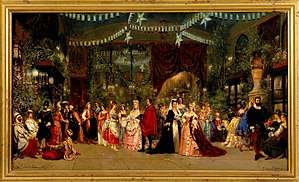Bal Travesti chez le baron Lycklama
The Costumed Ball at Baron Lycklama’s (formal title : “Bal Travesti chez le baron Lycklama”) is an 1874 oil painting on wood by Pierre Tetar van Elven housed in the Musée de la Castre in Cannes, France. Painted in March 1874, the painting depicts the scene at the Villa Escarras in Cannes, where Tinco Lycklama à Nijeholt (1837-1900) organised a fancy dress party on February 16, 1874 for the Carnival holiday – hosting over two hundred guests from the city’s international and local elites. The painting is an expression of the art of entertainment during the early days of the Belle Époque at the French Riviera. Two years earlier, in 1872, the then 35-year-old Dutchman Tinco Lycklama took up residence in Cannes, where he joined the fast-growing colony of foreign aristocrats and industrialists, who were acquiring and building luxury manors and villas in the sprawling resort. The majority of the international community would typically spend a few weeks or even months only during the winter, escaping from the cold in Northern Europe and Russia to the mild and healthy climate on the shores of the Mediterranean Sea.
| Costumed Ball at Baron Lycklama’s | |
|---|---|
 | |
| Artist | Pierre Tetar van Elven |
| Year | 1874 |
| Medium | Oil on wood |
| Dimensions | 48 cm × 81 cm (19 in × 32 in) |
| Location | Musée de la Castre, Cannes |
The painting reflects the active social life in Cannes. The artist, Belgian-born Pierre Tetar van Elven, a court painter for King Victor Emmanuel II of Italy, was a personal friend of Tinco Lycklama, and stayed at the latter’s Villa Escarras at the time of the ball. He also drew two known black-on-white sketches that further illustrate the nature of the ball.
One of the particularities about the ball is that the local newspaper “Les Echos de Cannes”, in its edition of February 21, 1874,[1] reported in detail about the participants and their costumes, as well as the general setting with the decoration, the menu, and the music. As a result, the majority of the characters portrayed in this painting are identified.
Inscriptions
The painting bears the inscriptions “Villa Escarras Cannes 1874” (bottom left), and “P. van Elven” (bottom right). On the back of the panel, it carries the inscription “Musée de la Castre. Fête donnée par le baron Lycklama à Nijeholt à Cannes. Mars 1874 peint par van Elven". The painting was donated to Cannes' municipal “Musée Lycklama" after the death of Tinco Lycklama (December 1900) by his widow, Baroness Juliana thoe Schwartzenberg en Hohenlansberg.
References
- |title=Archives Journaux, Archives Municipales de Cannes|url=http://archivesjournaux.ville-cannes.fr/dossiers/echos/1874/Jx5_Echos_Cannes_1874_02_21_Page_01.pdf